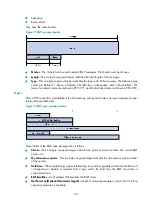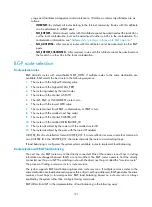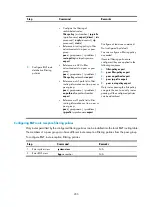
193
•
A BGP speaker advertises all routes to a newly connected peer.
BGP and IGP synchronization
Enable BGP and IGP route synchronization in an AS to avoid giving wrong directions to routers.
If a non-BGP router works in an AS, it can discard a packet because a destination is unreachable. As
shown in
, Router E has learned a route of 8.0.0.0/8 from Router D via BGP. Router E then sends
a packet to 8.0.0.0/8 through Router D, which finds from its routing table that Router B is the next hop
(configured using the
peer next-hop-local
command). Because Router D has learned the route to Router
B via IGP, it forwards the packet to Router C through route recursion. Router C is unaware of the route
8.0.0.0/8, so it discards the packet.
Figure 81
BGP and IGP synchronization in an AS
For this example, if synchronization is enabled, and the route 8.0.0.0/24 received from Router B is
available in its IGP routing table, Router D adds the route into its BGP routing table and advertises the
route to the EBGP peer.
You can disable the synchronization feature in the following situations:
•
The local AS is not a transitive AS (AS20 is a transitive AS in the above figure).
•
Routers in the local AS are IBGP fully meshed.
Settlements for problems in large scale BGP networks
Route summarization
Route summarization can reduce the routing table size on a large network, and allow BGP routers to
advertise only summary routes.
The system supports both manual and automatic route summarization. Manual route summarization
allows you to determine the attribute of a summary route and whether to advertise the route.
Route dampening
BGP route dampening solves the issue of route instability such as route flaps—a route comes up and
disappears in the routing table frequently.
When a route flap occurs, the routing protocol sends an update to its neighbor, and then the neighbor
must recalculate routes and modify the routing table. Frequent route flaps consume large bandwidth and
CPU resources, which could affect network operation.
















































